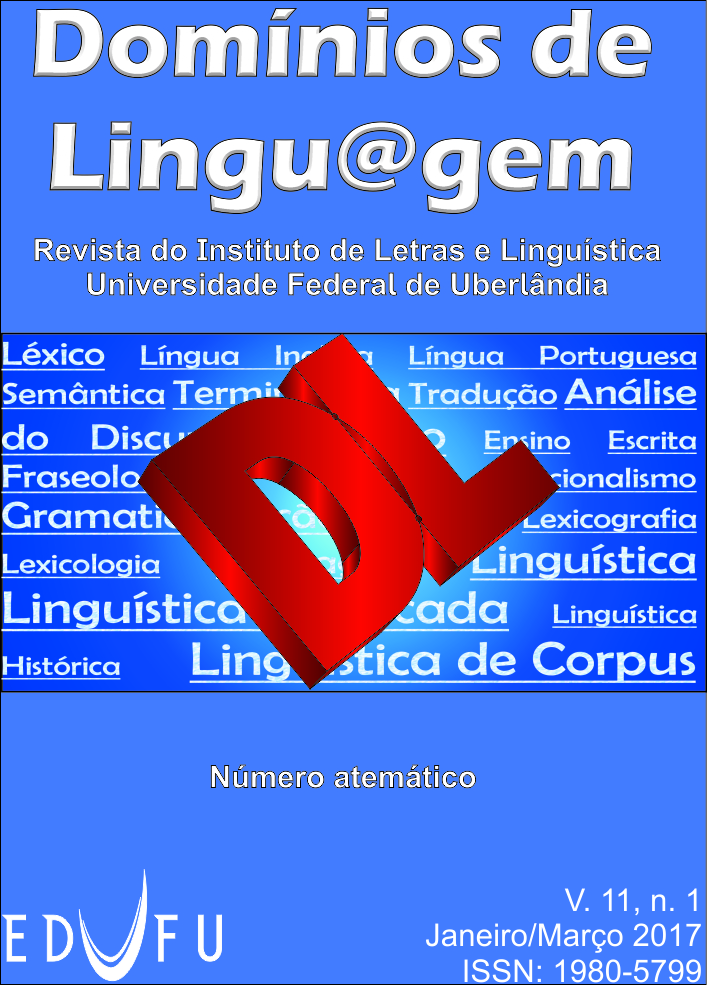Misconceptions about writing
the case of text production tips on YouTube videos
DOI:
https://doi.org/10.14393/DL28-v11n1a2017-9Keywords:
Portuguese Language, Writing, Tips, Internet, YouTubeAbstract
With this work, we intend to point out some misconceptions presented in Portuguese language teaching materials that focus on writing and are available in the format of videos on YouTube. Based on the assumptions of Text Linguistics, especially on the studies of Antunes (2005, 2007, 2009, 2010), on the conceptions of Bakhtin (2003, 2013) and Adam (2011) and on studies and reflections about mother tongue teaching, we analysed 04 videos which present tips that aim at developing writing in more formal situations of language usage. The results indicate that there are no proper instructions focusing on the nature of text and that take it as an object of study, and reflection as the focus still relies on grammatical elements and on the examination of decontextualized phrases. We conclude that the tips presented in these videos show a lack of understanding of the real functioning of texts, of writing, and interactive activity, showing, hence, little or no relation with recent contributions of Linguistics, especially those from Text Linguistics, Discourse Analysis and Stylistics.Downloads
References
ADAM, J. M. A linguística textual: uma introdução à análise textual dos discursos. Tradução de Maria das Graças Soares Rodrigues, Luis Passeggi, João Gomes da Silva Neto e Eulália Vera Lúcia Fraga Leurquin. Revisão Técnica: João Gomes das Silva Neto. 2. ed. revisada e aumentada. São Paulo: Cortez, 2011.
ANTUNES, I. Aula de Português: encontro e Interação. São Paulo: Parábola Editorial, 2003.
______. Lutar com palavras: coesão e coerência. São Paulo: Parábola Editorial, 2005.
______. Muito além da gramática: por um ensino de línguas sem pedras no caminho. São Paulo: Parábola Editorial, 2007.
______. Língua, texto e ensino: uma outra escola possível. São Paulo: Parábola Editorial, 2009.
______. Análise de textos: fundamentos e práticas. São Paulo: Parábola Editorial, 2010.
BAGNO, M. Língua, história & sociedade: breve retrospecto da norma-padrão brasileira. In: In: BAGNO, M. (Org.) Linguística da norma. 2 ed. São Paulo: Edições Loyola, 2004, p. 179-199.
______. O que é uma língua? Imaginário, ciência e hipóstese. In: LAGARES, X. C.; BAGNO, M. Políticas da norma e conceitos linguísticos. São Paulo: Parábola Editorial, 2011, p. 355-387.
BAKHTIN, M. Estética da criação verbal. Tradução do russo de Paulo Bezerra. 4. ed. São Paulo: Martins Fontes, 2003.
______. Questões de estilística no ensino da língua. Tradução, posfácio e notas de Sheila Grillo e Ekaterina Vólkova Américo. São Paulo: Editora 34, 2013.
BRASIL, Secretaria de Educação Fundamental. Parâmetros Curriculares Nacionais: terceiro e quarto ciclos do ensino fundamental: Língua Portuguesa/Secretaria de Educação Fundamental. Brasília: MEC/SEF, 2001.
BRITO, L. P. L. Em terra de surdos-mudos (um estudo sobre as condições de produção de textos escolares). In: GERALDI, J. W. (Org.). O texto na sala de aula. 3. ed. 5ª impressão. Ática: São Paulo: 2002, p. 117-126.
BRUCE, C. S. Information literacy research: dimensions of the emerging collective consciousness. Australian Academic & Research Libraries, v. 31, n. 2, p. 91-106, 2000. https://doi.org/10.1080/00048623.2000.10755119
BUZATO, M. E. K. Letramento digital abre portas para o conhecimento. EducaRede, 11 mar. 2003. Disponível em: <http://www.educarede.org.br/educa/html/index_busca.cfm>. Acesso em: 12 mar. 2004.
CASTILHO, A. T. de. Gramática do Português Brasileiro. São Paulo: Contexto, 2010.
DEMO, P. O educador e a prática da pesquisa. Ribeirão Preto: Editora Alphabeto, 2009.
FARACO, C. A. Norma-padrão brasileira: desembaraçando alguns nós. In: BAGNO, M. (Org.) Linguística da norma. 2 ed. São Paulo: Edições Loyola, 2004, p. 37-61.
GARCIA, O. M. Comunicação em prosa moderna. 27. ed. Rio de Janeiro: Ed. da FGV, 2010.
GERALDI, J. W. Unidades básicas do ensino de português. In: ______. GERALDI, J. W. (Org.). O texto na sala de aula. 3. ed. 5ª impressão. Ática: São Paulo: 2002, p. 57-79.
KOCK, I. V.; ELIAS, V. M. Ler e escrever: estratégias de produção textual. São Paulo: Contexto, 2009.
LÉVY, P. Cibercultura. Tradução de Carlos Irineu da Costa. São Paulo: Ed. 34, 1999.
LISPECTOR, C. A descoberta do mundo. Rio de Janeiro: Roco, 2008. Disponível em: <http://minhateca.com.br/nonedoubt/Documentos/last+books/LIVROS/Clarice+Lispector/Clarice+Lispector+-+A+Descoberta+Do+Mundo,2365784.pdf>. Acesso em 29 jul. 2014.
MORAN, J. M. Como utilizar a internet na educação. Ci. Inf. v. 26 n. 2, Brasilia May/Aug. 1997. Disponível em: <http://www.scielo.br/scielo.php?pid=s0100-19651997000200006&script=sci_arttext>. Acesso em 26 jul. 2014.
SCHERRE, M. M. P. Doa-se lindos filhotes de poodle: variação linguística, mídia e preconceito. São Paulo: Parábola Editorial, 2005.
SQUARISI, D.; SALVADOR, A. A arte de escrever bem: um guia para jornalistas e profissionais do texto. 5. ed. 1ª reimpressão. São Paulo: Contexto, 2008a.
______. Escrever melhor: guia para passar os textos a limpo. 1. ed. 2ª reimpressão. São Paulo: Contexto, 2008b.
WATERS, L. Inimigos da esperança: publicar, perecer e o eclipse da erudição. Tradução de Luiz Henrique de Araújo Dutra. São Paulo: Editora da UNESP, 2006.
Downloads
Published
Issue
Section
License
Authors who publish in this journal agree to the following terms:
Authors retain the copyright and waiver the journal the right of first publication, with the work simultaneously licensed under the Creative Commons Attribution License (CC BY-NC-ND 4.0), allowing the sharing of work with authorship recognition and preventing its commercial use.
Authors are authorized to take additional contracts separately, for non-exclusive distribution of the version of the work published in this journal (publish in institutional repository or as a book chapter), with acknowledgment of authorship and initial publication in this journal.









